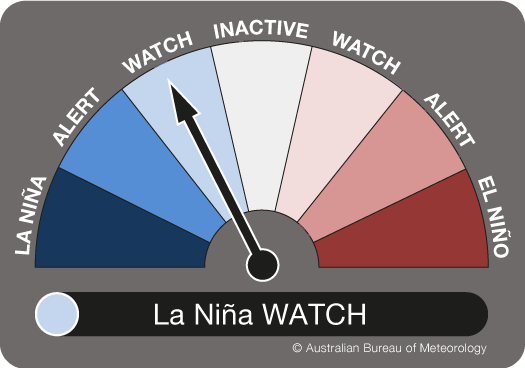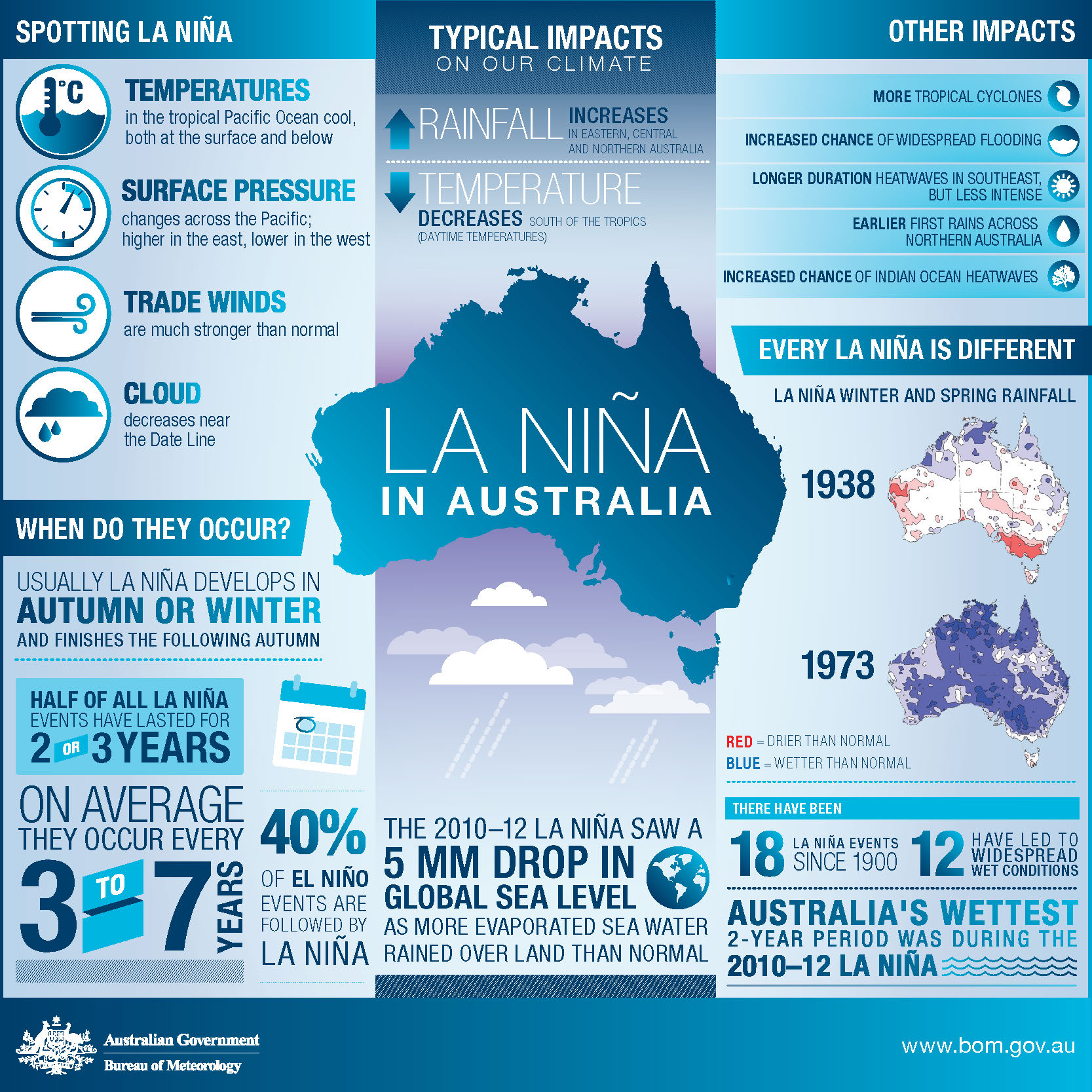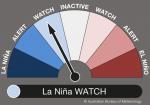La Niña WATCH: what it means for 2020
17 July 2020
The Bureau's ENSO Outlook assesses the likely evolution of the El Niño–Southern Oscillation—the cycle of El Niño, La Niña and neutral conditions in the tropical Pacific Ocean. It uses a staged approach to advise of the likelihood of an El Niño or La Niña in the months ahead. In mid-June 2020, the outlook moved from 'INACTIVE' to 'La Niña WATCH'—so, what does this mean for Australia's climate in the coming months?
When the needle is at La Niña WATCH, it means that there's about a 50 per cent chance of a La Niña developing in the months ahead. While a 50 per cent chance may sound no better than just tossing a coin, it's actually a little more than double the normal likelihood of a La Niña occurring in any year.
Of course, with a 50% chance of an event, a La Niña WATCH is certainly not a guarantee that a La Niña will happen. But it does indicate that at least some of the typical La Niña precursors are in place.

Graphic: the Bureau's ENSO outlook is currently at La Niña WATCH (July 2020)
What are the effects on Australia's climate during La Niña WATCH?
The typical effects of La Niña—more rainfall and cooler daytime temperatures over parts of Australia during winter and spring—can still occur even if we approach, but don’t actually reach, La Niña status.
Usually those impacts won't last as long or affect as large an area as would occur during a fully-fledged La Niña, since the weather patterns—typically lower than average pressure meaning more cloud and rain over Australia—may be influenced by the cooling Pacific Ocean, but don't get locked in.
And essentially that’s what a La Niña declaration really means—that the tropical Pacific the ocean has 'coupled' with the atmosphere, meaning the cooler oceans drive changes in the atmosphere, which in turn cools the ocean even more.
When this positive reinforcement loop occurs, we have a La Niña event, and it typically doesn’t end until early the following year. Likewise, the weather patterns over Australia stay locked in until then too.
So, now's the time to think about possible actions, and what a wet winter or spring could mean for you (or if you're susceptible to flooding), should a La Niña develop. This will put you into a better place should we move to the next stage of La Niña preparedness.

Image: Typical influences on Australia’s climate during a La Niña event
So where to next from La Niña WATCH?
The three stages of the ENSO Outlook are designed to reflect the level of confidence that climatologists have that an ENSO event may occur in the months ahead.
For a stage to be reached, our climatologists assess whether a set of observed atmospheric and oceanic criteria—the typical precursors to an event—have been met.
They also review eight international climate models to see how many are forecasting an event, and if those models suggest an event will last for at least two to three months.
Once the ENSO Outlook status has reached La Niña WATCH, there are three possible paths:
- Stay at La Niña WATCH;
- Move up to La Niña ALERT (around a 70 per cent chance of La Niña occurring, roughly triple the normal risk); or
- The La Niña WATCH could be cancelled, returning the dial to INACTIVE.
For example, in November 2016, the La Niña WATCH that had been active for several months weakened back to INACTIVE. In contrast, the La Niña WATCH in October 2017 strengthened to a La Niña ALERT before reaching LA NIÑA status in late November, meaning an event was declared.
Our ENSO Outlook criteria describes what needs to occur before we shift into La Niña ALERT.
Image: ENSO Outlook values from January 2015 to July 2019
Is it always a slow and steady change in likelihood?
In some instances, things turn out differently to what might be expected. Back in October 2000, La Niña conditions in the Pacific Ocean developed so quickly that the ENSO Outlook swung from INACTIVE to La Niña ALERT, skipping La Niña WATCH entirely, and meeting LA NIÑA criteria by the end of the . But these rapid developments are the exceptions rather than the rule.
Sometimes the Pacific Ocean can tease us, threatening an event for months before it vanishes without a fully-fledged event ever developing. In 2016, following a strong El Niño, the ENSO Outlook pointed to La Niña WATCH for eight months, before dropping back to INACTIVE in late November.
And at other times it can be a long wait until an event develops. For instance, in 1984 we were at La Niña WATCH for six months (from March to August), before swinging through La Niña ALERT into LA NIÑA in November, where the dial stayed until the event was deemed over by Bureau climatologists.
So, while the needle points to La Niña WATCH right now, make sure you keep an eye on our ENSO Outlook for any updates, and prepare ahead of time for potentially challenging—or rewarding—climate conditions.
More information
The ENSO Outlook is updated fortnightly with the Climate Driver Update (formerly the ENSO Wrap-Up).



Comment. Tell us what you think of this article.
Share. Tell others.